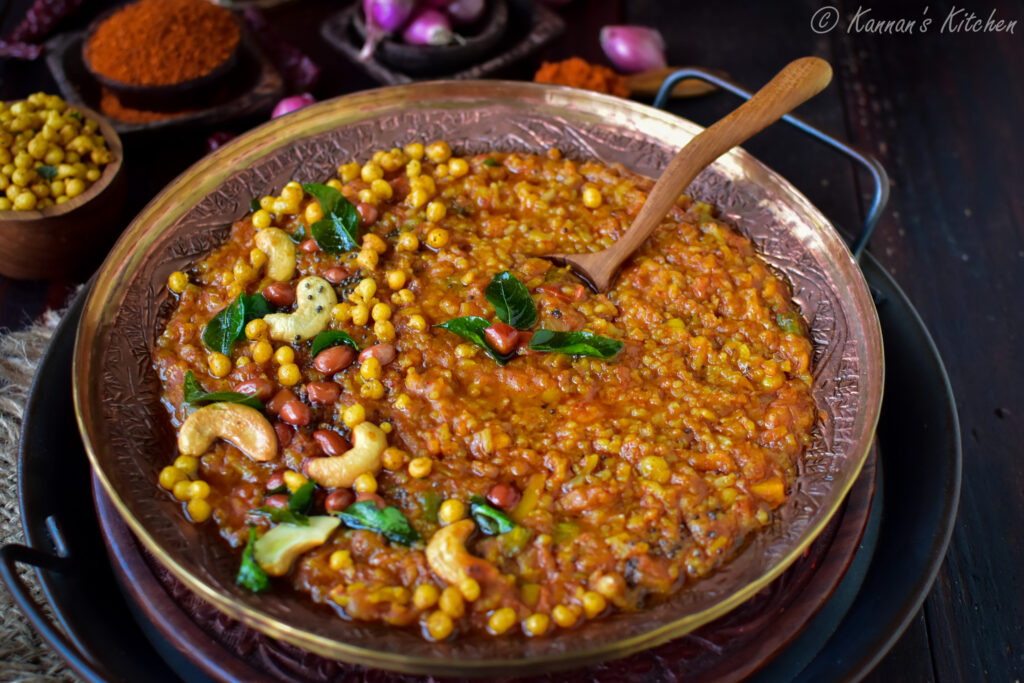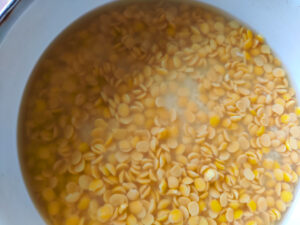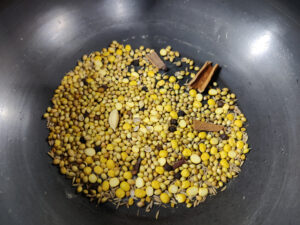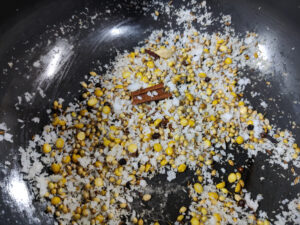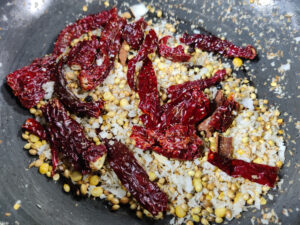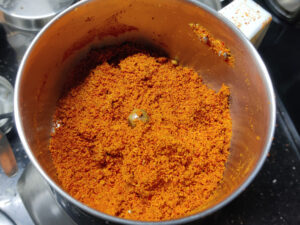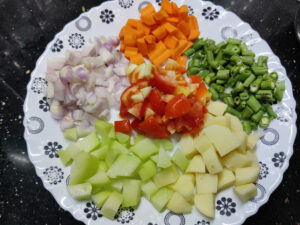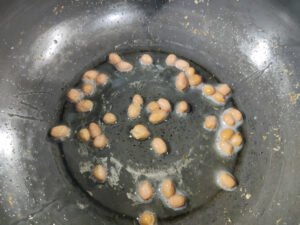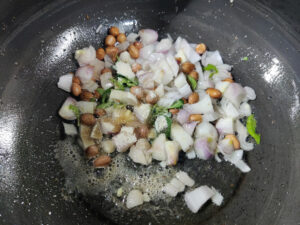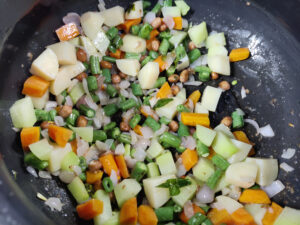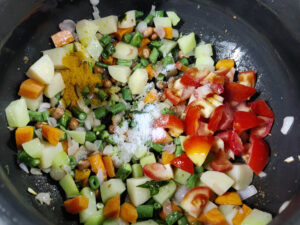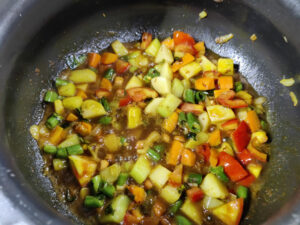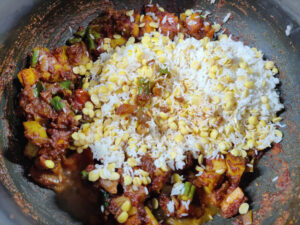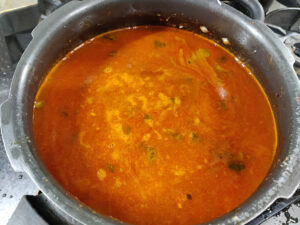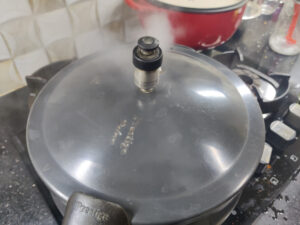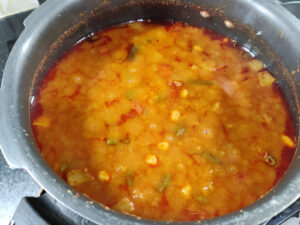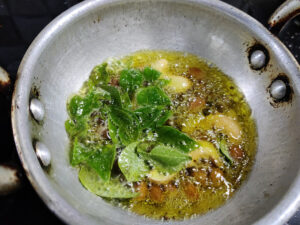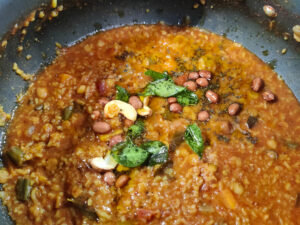Bisi Bele Bath
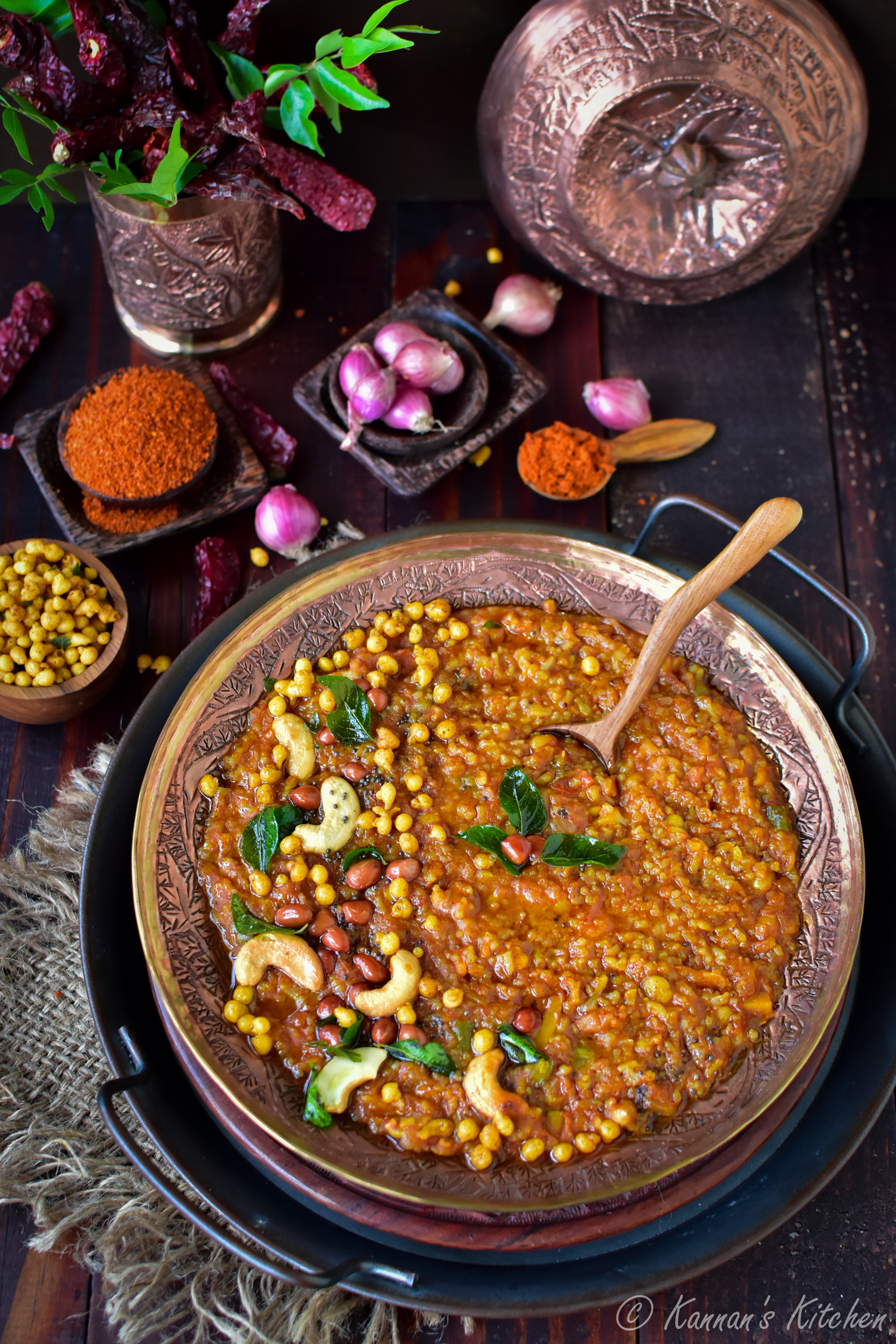
Bisi Bele Bath is a wholesome rice and lentil based dish from the southern state of Karnataka in India. It is a flavourful khichdi like dish made using toor dal, rice, assorted veggies cooked with tamarind and a freshly ground bright red spice powder. This is an extremely popular dish which is served both for breakfast and lunch.
Bisi Bela Bath literally translates to hot lentil and rice dish in Kannada. Bisi means hot, Bela means lentil and bath is referred to rice based dish. Needless to say, this dish tastes best when it is piping hot with a generous serving of ghee on top of it. It is an absolute comfort food for me and I relish on any given day, especially after a long vacation. This version of recipe is a one-pot meal and pretty quick to cook.
Bisi Bele Bath is a well balanced dish not just in terms of nutrition, with the right amount of protein, carbohydrates and nutrients from vegetables, but also in terms of the taste. It is a perfect medley of fragrant spices, heat from chillies, sourness from tamarind and slight sweetness from jaggery.
The heart and soul of this dish is the freshly ground bisi bele bath masala. There are a bunch of spices that go in this masala and to name a few – cinnamon, cloves, pepper, cardamom, cumin, poppy seeds, byadagi red chillies, corriander seeds, dry coconut, channa dal etc. The vibrant red colour of this masala and rice comes from the Byadagi red chillies which are mild in heat, however imparts the dish a deep rich colour. I highly recommend making this masala fresh rather than preparing in bulk and storing, or using the readymade powders. Trust me, this spice powder is so fragrant and aromatic that I just keep smelling the blender jar soon after grinding it 🙂
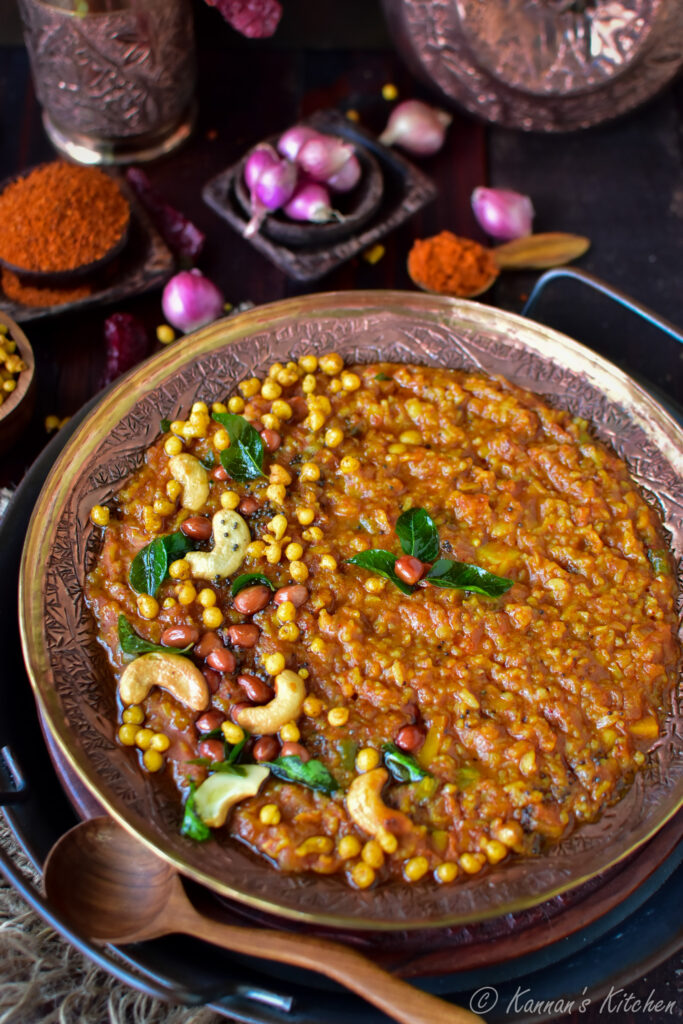
Bisi Bele Bath being a staple and traditional dish in many South-Indian households, each family has it’s own technique and recipe for making this dish. However, the underlying ingredients remain pretty much the same. You could use veggies of your choice, however carrots, beans, potatoes, chow-chow are the most common ones in this dish. This dish is often confused with the Sambar Sadam or Sambar Rice from Tamil Nadu, but it is to be noted that the taste of Bisi Bele Bath is quite different from Sambar rice due to the spice blend.
Traditionally, the rice and toor dal are cooked first separately and then mixed in the tamarind based vegetable gravy along with the spice powder and simmered. However, in our home we have a slightly different way of cooking this dish and is much simpler and efficient, as it is a one-pot technique where the lentils, rice and veggies are all pressure cooked together in the spice mix. I prefer this technique as it is not only quick, but the spices also get absorbed really well into the rice and veggies and is extremely aromatic. This method is also a boon when you are in a hurry and is an excellent way to spin up a delicious wholesome meal in minutes.
There are few important things to get a perfect Bisi Bele Bath, and if any of the below goes wrong, it is not so much fun to have this dish. I have given the perfect measurements and ratio in this recipe which will yield a perfect and yummy dish without fail.
Consistency – Bisi Bele Bath is always served in a khichdi like consistency which is not too runny and not too thick. The rice grains must be still visible, however not too whole. The secret to get this consistency in one pot technique is the right ratio of water to rice. So follow the exact measurements in this recipe for the right consistency.
Freshly Ground Spice Powder – Try to make the spice blend fresh as it works best for this dish.
Balance of Sweet, Sour and Spice levels – Bisi Bele Bath must be perfectly balanced in these 3 aspects. Use Byadagi red chillies for the right amount of heat and colour. Jaggery is added to balance the sourness from tamarind and do not skip this ingredient.
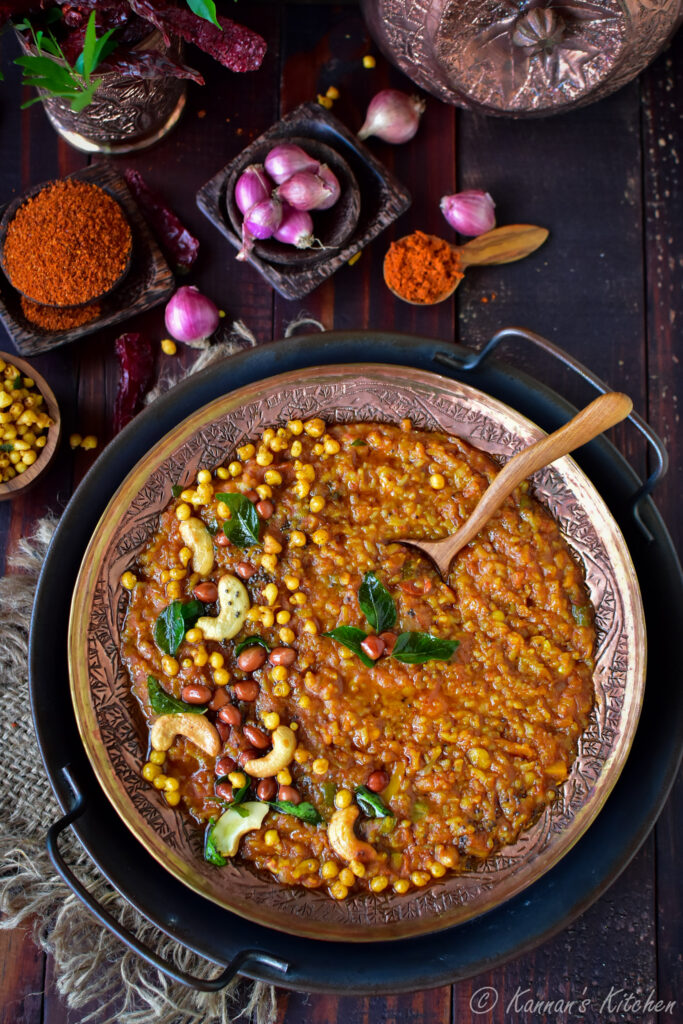
Serving Suggestion
Bisi Bele Bath is a wholesome meal in itself. It is generally served piping hot with a generous serving of ghee on top and some Kara Boondi sprinkled over. Fried papad or chips and raitha also pairs well with Bisi Bele Bath.
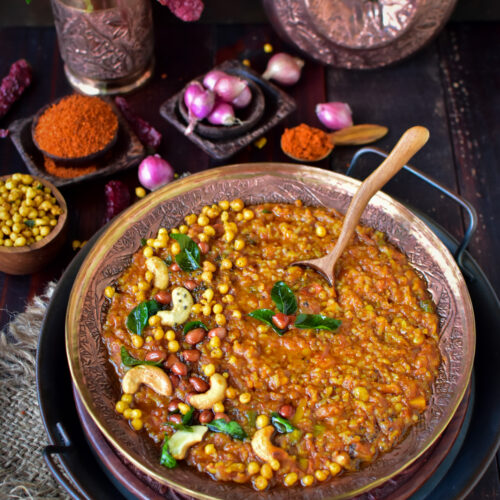
Bisi Bele Bath
Equipment
- Pressure Cooker
- Standard Measuring Cups and Spoons
Ingredients
For Bisi Bele Bath Masala
- 2 inch Cinnamon
- 3 Cloves
- 2 Green Cardamom
- ¼ tsp Fenugreek or Methi Seeds
- ½ tsp Peppercorns
- 1½ tbsp Channa Dal
- 2 tbsp Coriander Seeds
- 7-8 Byadagi Dry Red Chillies
- 3-4 tbsp Grated Coconut or Khopra
- 1 tsp Poppy Seeds
- 1 tsp Jeera or Cumin Seeds
For Bisi Bele Bath
- ⅓ cup Toor Dal
- ⅔ cup Sona Masuri or any other Raw Rice
- Lime sized Tamarind
- 2 tbsp Jaggery
- 8-10 Madras Small Onion or 1 large Onion
- 2 Carrots
- 100 gms French Beans
- 1 Large sized Potato
- 2 Small sized Tomatoes
- 100 gms Chow Chow
- 3-4 sprigs Curry Leaves
- 4 tbsp Groundnuts
- 1 tsp Turmeric Powder
- ¼ tsp Asafoetida
- 1½ tsp Mustard Seeds
- 8-10 nos. Cashews
- 5 cups Water
- 2 tbsp Oil
- 4 tbsp Ghee
- Salt to taste
Instructions
- Soak Tamarind in half a cup of water for around 20 minutes.
- Soak toor dal in water for 30 minutes. You can use luke warm water.
- For making the masala, heat a pan and on low flame, add the whole spices – cinnamon, cloves, peppercorn and cardamom and dry roast. Next add channa dal, fenugreek seeds, jeera and roast till aromatic. Next add coriander seeds.
- If you are using fresh grated coconut, add this next and roast till it is golden colour. If you are using khopra, it would not take long.
- Finally add the Byadagi red chillies and poppy seeds and roast for few seconds. Turn off the stove and let this mixture cool completely.
- Now blend this mixture to a fine powder in mixer grinder. Keep masala aside.
- Chop all the veggies as shown in image.
- For making Bisi bele bath, heat 2 tablespoon oil in a pressure cooker. Add 2 tablespoons of groundnut and roast till it changes colour. Next add 2 sprigs curry leaves.
- Next add the onions, asafoetida and cook for couple of minutes.
- Next, add all the chopped veggies and sauté for couple of minutes.
- Now add the chopped tomatoes, salt to taste and turmeric powder. Cook for another couple of minutes.
- Squeeze the pulp of the tamarind and discard the flesh.
- Add the tamarind pulp to the veggies and let it come to a boil.
- Now add the bisi bele bath spice mix (whole of it), jaggery and mix well. Cook for 1-2 minutes.
- Add the soaked toor dal and washed rice. Add salt and mix well.
- Add 5 cups of water (1:5 for rice+dal : water). Mix well.
- Close the pressure cooker lid and let it cook on medium flame for 5-6 whistles.
- Once the pressure is released, mix the rice gently. Do not mash too much. The excess liquid gets absorbed by itself on mixing and tends to thicken in few minutes.
- For the tempering, heat 3-4 tablespoons of ghee in a pan, add the mustard seeds, 2 tablespoons groundnuts and roast till groundnut starts changing colour. Add the cashews next and the curry leaves too.
- Add this tempering to rice and mix gently. Serve hot with more ghee if required, and kara boondi sprinkled over top.
Notes
- In this recipe, since we are cooking rice and dal together, the dal is to be soaked for roughly 30 minutes so that it cooks as same time as rice. You can soak the dal for longer too or just when you do the prep work for making the rice.
- I have used Byadagi red chillies which is traditionally used in Karnataka cuisine. It imparts bright red colour to the dish and is not spicy. If you cannot find this variety, you can use the same amount of Kashmiri Red Chillies. If you are using the spicier variety like Guntur chilli, reduce the number of chillies accordingly.
- The quantity given for the spice masala works just right for the amount of rice specified. So use the whole of it. Also note that the spoons and cups used are of standard size.
- It is important to note that the consistency of rice should be just right after cooking – not too watery and not too thick. I follow a ratio of 1:5 for (rice+dal): water and works perfectly fine.
- You can follow the same recipe in Instant Pot too as against a pressure cooker.
- Do not skip the jaggery, as it is an important ingredient and it’s sweetness balances the spice level and sourness from tamarind.
- I like using Madras small onions for this recipe, however you can use the regular onion too.
- Just like khichdi, this dish tastes best when served with plenty of ghee. Do serve it piping hot!
